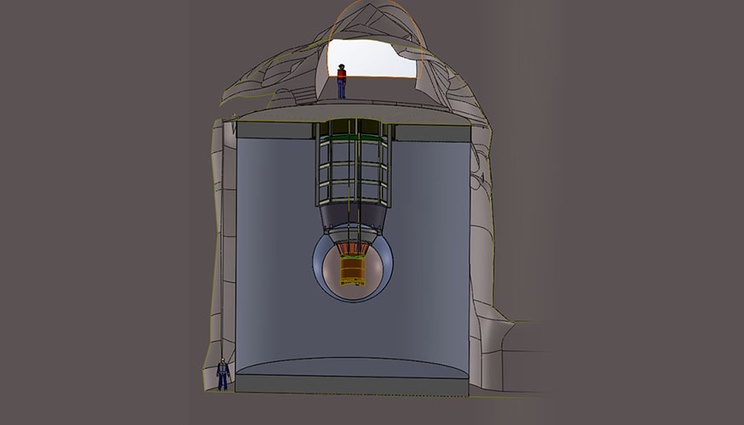Lab-led nEXO project receives Inflation Reduction Act funding
 (Download Image)
(Download Image)
Human silhouettes illustrate the scale of the nEXO detector, which will be built in a cavern two kilometers underground. The xenon, located in the center, is protected from radioactive background by a cylindrical copper vessel, a sphere of special fluid and a water tank.
Lawrence Livermore National Laboratory (LLNL) has received $2.35 million from the Inflation Reduction Act, which aims to support domestic energy production and promote clean energy and to provide the Department of Energy (DOE) national laboratories with resources to keep the U.S. at the forefront of scientific discovery.
The funding has been allocated for the Lab-led nEXO project, which was created to understand neutrinos — tiny, nearly massless particles with no charge. The goal of the nEXO experiment is to search for a rare type of nuclear decay called neutrinoless double beta decay (NDBD). Double beta decay is a process where a nucleus decays into another one and emits two electrons and two antineutrinos. A special version of double beta decay — the “neutrinoless” version — emits only two electrons and no antineutrinos. If this is found, it would be a major discovery observing the generation of matter without antimatter and would provide insight into the formation of the universe.
Specifically, the funding will advance the nEXO project toward the first DOE project directive (DOE O413.3b milestone, CD1), which provides direction for the acquisition of capital assets.
“The nEXO project will provide information about the nature of the neutrino and ultimately insight to why we exist,” said LLNL physicist and project director Mike Heffner. “Furthering the understanding of neutrinos and their properties provides tremendous insight into the formation of the universe. nEXO is designed to address this top DOE nuclear physics mission need and will provide important U.S. scientific leadership in the world.”
The project is funded by DOE’s Office of Science and is a joint effort among approximately 200 scientists and technologists from 36 institutions and eight countries, including five DOE national laboratories and more than a dozen U.S. universities.
“The nEXO collaboration combines expertise from all over the world to develop detector technology that will allow nEXO to achieve unprecedented sensitivity to neutrinoless double beta decays,” Heffner said. “This collaboration will advance our understanding of one of the greatest scientific questions of our time: ‘What is the nature of the neutrino?’”
To learn more about DOE projects funded by the IRA, visit the web.
Contact
 Michael Padilla
Michael Padilla
[email protected]
(925) 341-8692
Related Links
nEXODOE O413.3b milestone, CD1
DOE
Tags
NeutrinosnEXO
Nuclear, Chem, and Isotopic S&T
Nuclear and Chemical Sciences
Physical and Life Sciences
Energy
Science
Featured Articles







